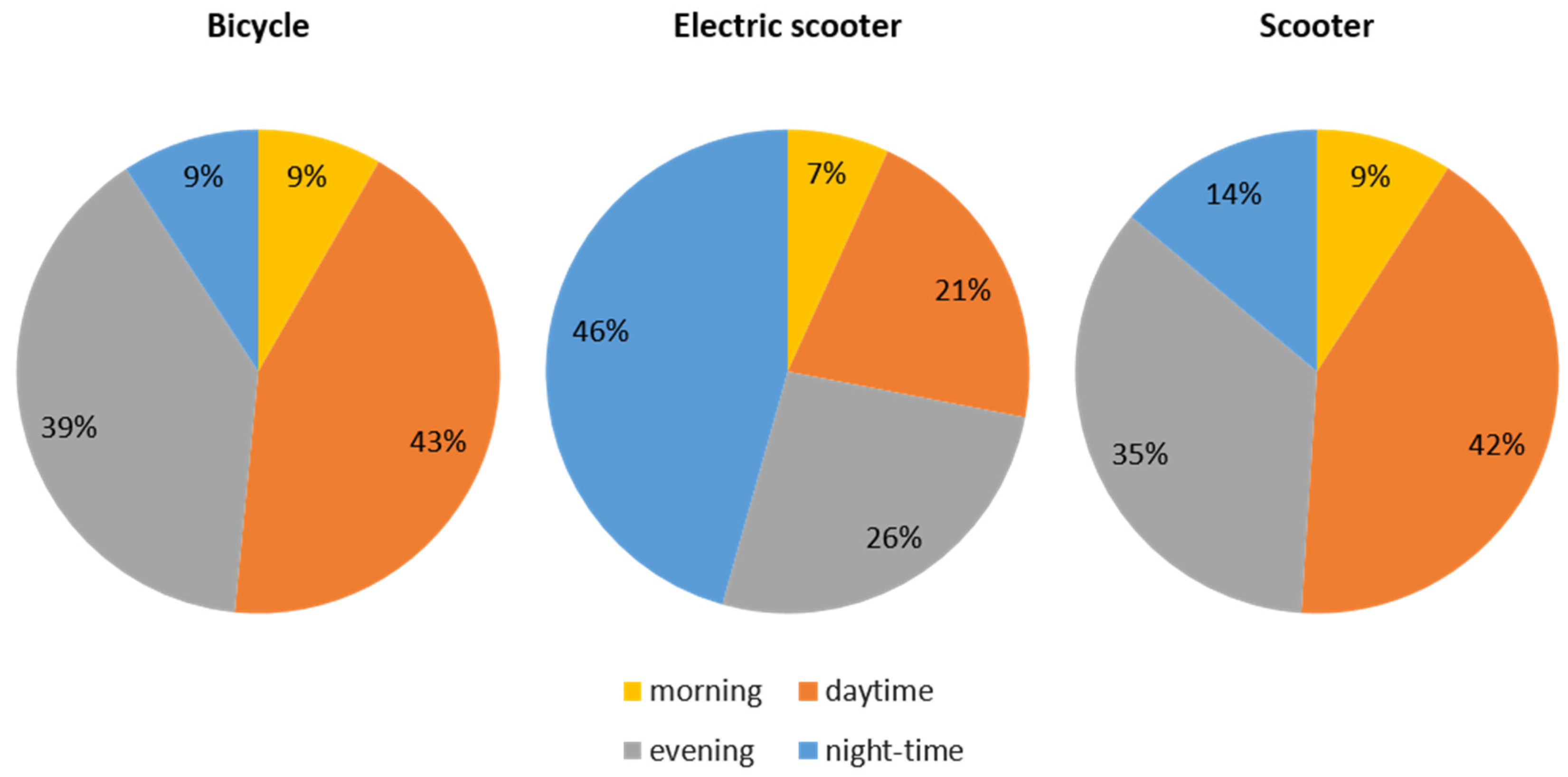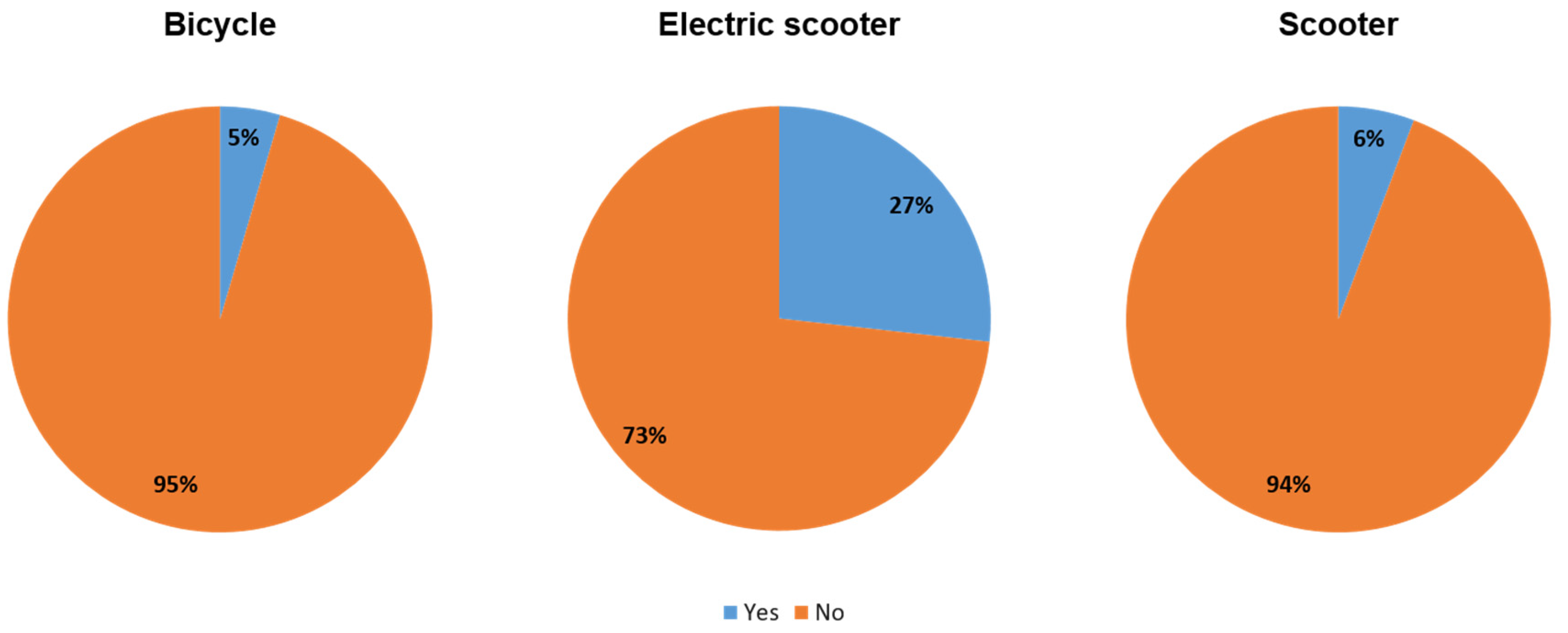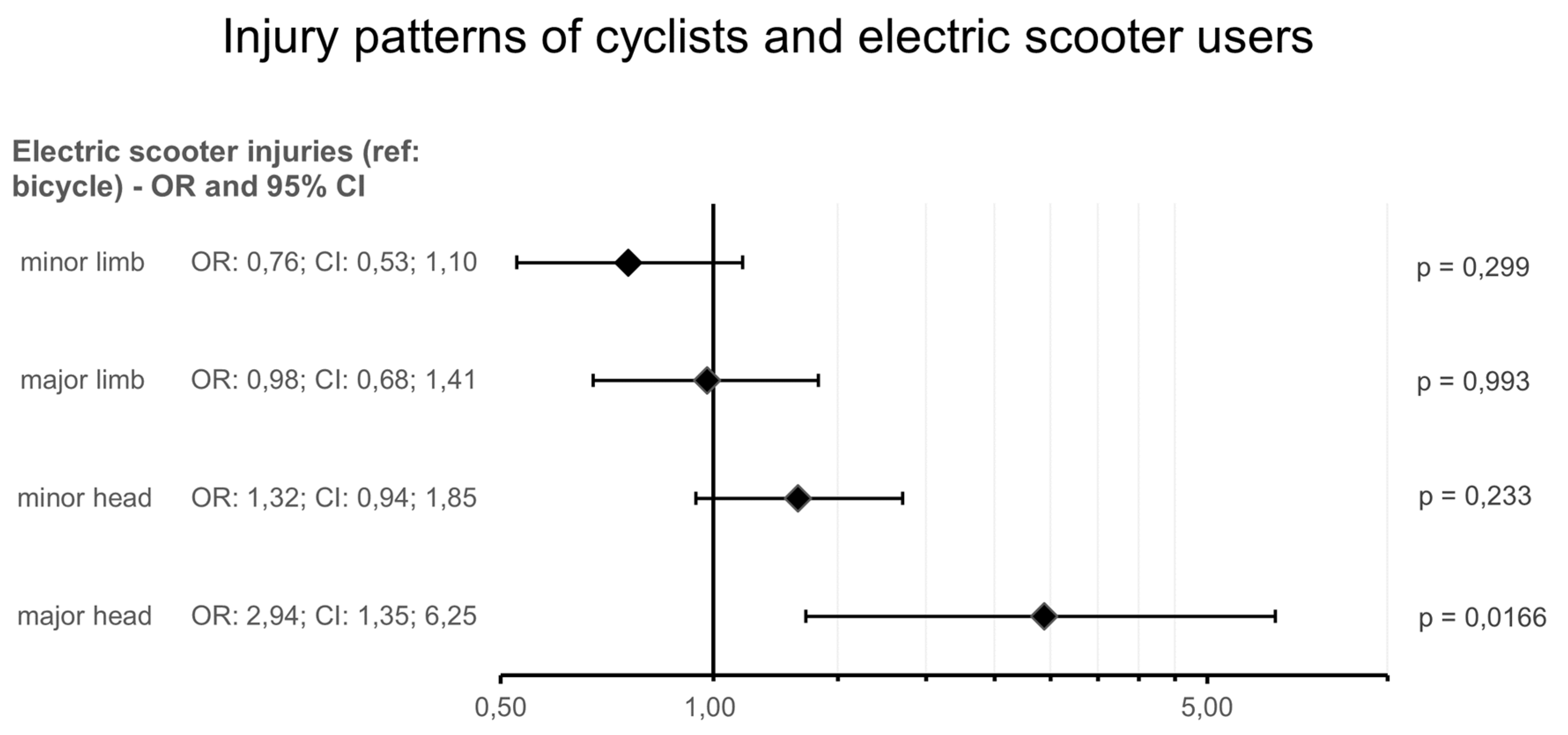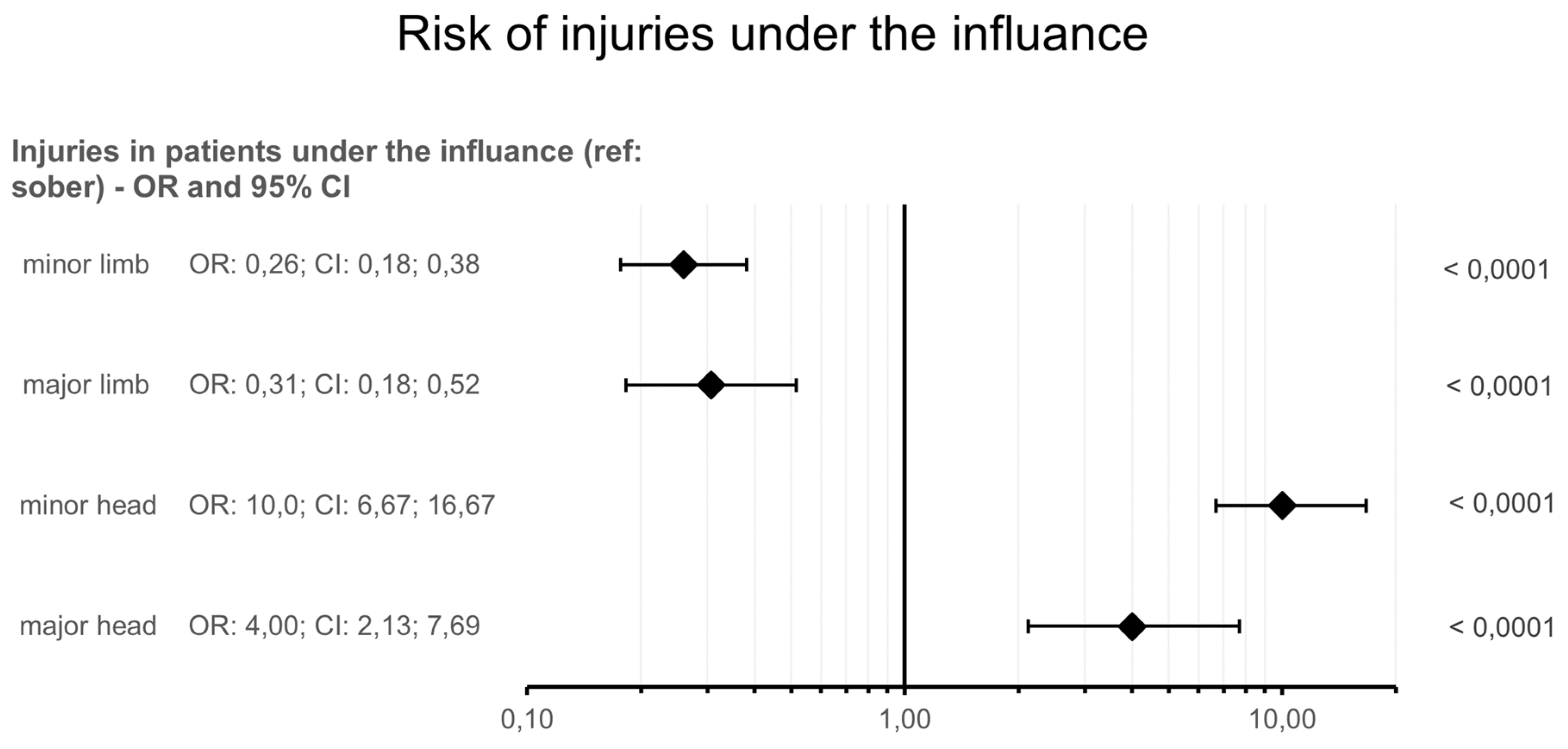1. Introduction
The rapid urbanization of cities worldwide has brought advancements in transportation and unprecedented challenges. Micro-mobility devices (public-sharing electric scooters (e-scooters) and electric bikes) have become increasingly popular worldwide, offering a convenient and affordable solution to this "first/last mile" problem while also reducing the carbon footprint of cities [
1,
2]. Following their initial widespread introduction in the United States (US) in 2017, e-scooters witnessed a surge, with reports indicating over 38.5 million units in 2018 and a subsequent rise in European adoption [
3,
4].
However, the benefits of e-scooters come with associated risks. Recent studies have highlighted a significant increase in e-scooter-related injuries, with the potential for severe accidents due to factors like high speeds (30-35 km/h) and intoxicated riding. Riders are subject to severe injuries such as traumatic brain injuries and craniomaxillofacial and limb fractures. Several studies report the lack of helmet usage, suggesting an association with more frequent and higher severity head traumas [
5,
6,
7,
8,
9,
10,
11,
12]. The high incidence of intoxicated riding, estimated between 4.8% and 50%, increases the susceptibility of these vehicles to severe accidents [
1,
4,
5,
13,
14], as alcohol consumption impairs reaction time and balance [
14].
Namiri et al. reported a 222% rise in e-scooter injuries and a 365% surge in related hospital admissions in the US from 2014 to 2018 [
15]. This growing trend, coupled with the severity of injuries, has not only raised public health concerns but also spotlighted potential healthcare cost implications [
16]. In New Zealand, e-scooter injuries amounted to 1.3 million NZD over seven months, averaging 1300 NZD per available e-scooter [
4].
In Hungary, e-scooters were introduced in 2019. However, the legislative framework has been slow to adapt, resulting in challenges in categorizing e-scooters and obtaining accurate accident data. Current regulations neither mandate helmet usage nor prohibit intoxicated operation, and due to the absence of a distinct legal category for e-scooters, they're often treated similarly to bicycles. This legislative ambiguity is not unique to Hungary; cities like Paris have acted decisively by choosing to ban these vehicles from September 2023, highlighting the pressing need to address e-scooter safety [
5].
This study aims to analyze the injury patterns and accident characteristics of electric scooters (e-scooters), scooters, and bicycles in a Hungarian level-1 trauma center over a year. We seek to understand the unique and shared injury profiles among these modes of transport to inform safer urban transportation policies and trauma care protocols in Hungary.
2. Materials and Methods
We conducted a prospective observational study on 1938 patients who presented to Hungary’s largest trauma center between 1st April 2021 and 31st March 2022 with injuries from riding a bicycle, e-scooter, or scooter. Patients were categorized based on their vehicle type: bicycle, standing electric scooters, and non-motorized scooters. From medical documentation, we recorded age, sex, injury date, presentation time, alcohol influence, hospitalization need, duration, and injury type and severity. Presentation times were grouped as mornings (5 am-10 am), daytime (10 am-6 pm), evenings (6 pm-10 pm), and night-time (10 pm-5 am), with intervals adjusted proportionally.
We categorized injuries based on affected regions: extremities, head and face, spine, and the core (encompassing thoracic and abdominal areas). For diagnosis, physical examinations and basic X-ray scans were employed for minor injuries, while CT scans were used for more severe cases. Injuries were further classified as mild or severe. Mild injuries to limbs included contusions, abrasions, and superficial wounds without deep tissue damage, while severe ones involved fractures or tears in ligaments or muscles. Mild head injuries comprised superficial wounds and contusions in the craniomaxillofacial region, whereas severe ones involved fractures or intracranial bleeds like epidural, subdural, subarachnoid, and parenchymal hemorrhages. Mild core injuries were superficial wounds and contusions, while severe ones included fractures, penetrating wounds, or organ damage. Spinal injuries ranged from distortions and dislocations to fractures.
Statistical analysis involved fitting a logistic regression model for each trauma type and severity. Predictors included vehicle type, intoxication, and presentation time, controlling for age and sex. Multicollinearity, interactions, and age non-linearity were assessed, but no relevant ones were found. Results were reported with Wald-type p-values, adjusted odds ratios (OR), and 95% confidence intervals (CI). Categorical variables with multiple levels (more than 2) had Tukey-adjusted p-values and marginal mean differences. All analyses utilized R (R Core Team 2023, v4.2.3).
3. Results
In the one-year period, we observed and treated 1,938 patients for injuries related to different types of micro-mobility devices; 1378 patients visited our trauma centre on bicycles, 370 with e-scooters, and 190 with non-motorized scooter-related injuries, 1938 altogether. The mean age of injured cyclists was 37.9 years (SD (standard deviation): 14.9 years), older than e-scooter (mean: 31.3 years, SD: 10.1 years) or scooter (mean: 30.6 years, SD: 13.7 years) users. In the bicycle group, 30.8% were female, 69.2% were male; among e-scooter users, 33.8% were female, 66.2% were male, and in the scooter group, 41.1% were female and 58.9% were male. (
Table 1)
Regarding the timing of injuries, 8.3 % of bicycle injuries happened in the morning, 43.3 % in the daytime, 39.2 % in the evening, and 9.2 % at night-time. These proportions for the e-scooter group were 6.8 %, 21.3 %, 26.0 %, and 45.8 %, and for the scooter, group, were 9.2 %, 42.0 %, 34.6 %, and 14.1 %, respectively. (
Figure 1)
Before their accidents, 4.6% of cyclists consumed alcohol, 26.8% of e-scooter users, and 5.8% of scooter users. (
Figure 2) The hospitalization rate of the bicycle group was 10.3%, 14.6% for the e-scooter group, and 6.8% for the scooter group. The mean time spent in hospital was 2.30, 3.13 and 1.83 days, respectively.
Regarding injury severity, 78.9% of cyclists suffered mild, and 25.3% had severe extremity trauma. No significant difference was noted between e-scooter (70.8% mild, 25.4% severe) and scooter groups (74.7% mild, 23.7% severe) (
Figure 3). However, in the bicycle group, 29.9% suffered mild and 3.3% suffered severe facial or cranial injuries, while the rates were 50.8% and 9.2% in the e-scooter group. A significant difference was observed in the occurrence of severe head trauma (OR: 0.34, CI: 0.16; 0.74, p = 0.0166). Nevertheless, 36.8% and 5.8% of the scooter group suffered these types of injuries, with no significant difference from the other groups (
Figure 3).
Spinal injuries were present in 4.28% of cyclists, 1.9% of e-scooter users, and 1.1% of scooter users. Mild and severe abdominal or thoracic trauma was reported in 13.4% and 2.1% of cyclists, 9.2% and 1.9% of e-scooter users, and 6.8% and 0.5% of scooter users (
Table 2).
For mild limb injuries, 79.8% of sober and 44.7% of intoxicated patients suffered such injuries (OR: 3.85, CI: 2.62; 5.65, p < 0.0001). For severe limb injury, these rates were 26.5% and 11.6%, respectively (OR: 3.26, CI: 1.94; 5.47, p < 0.0001). Sober patients had a lower rate of mild head injury (29.5%) compared with intoxicated patients (86.1%) (OR: 0.1, CI: 0.06; 0.15, p < 0.0001). These rates were 3.3% and 18.5% for severe head injury, respectively (OR: 0.25, CI: 0.13; 0.47, p < 0.0001). Mild body trauma was experienced by 12.6% of sober patients and 4.6% of drunk patients (OR: 3.2, CI: 1.42; 7.21, p = 0.0051). For other injuries, no significant effect of alcohol consumption was found. (
Figure 4)
4. Discussion
Based on our results and previous studies, it is evident that e-scooters have resulted in a rise in the number of patients admitted to trauma care centres globally, suffering from distinctive injury patterns, especially head injuries [
17]. In Hungary, we observed a similar trend. This may be partly explained by the fact that, in many places, these devices are used in an intoxicated state due to regulatory deficiencies [
1,
4,
13,
14,
18,
19]. The heightened interest of clinicians in this topic is illustrated by many publications regarding e-rollers in the last few years [
17]. While previous studies have mainly focused on injury patterns associated with electric scooters, it is worth noting that there has been no comparative research on injuries sustained while riding bicycles, scooters, and electric scooters within the same one-year period. This study aimed to comprehensively characterize and compare this novel patient group with better-understood bicycle users, enhancing patient care and laying the groundwork for an evidence-based regulatory framework.
In the literature, the mean age of patients with electric scooter-related injuries ranged from 32 to 36 years [
3,
5,
13]. In our study group, the mean age of patients with e-scooter-related injuries was consistent with this trend at 31.3 years. These people were younger than the patients injured riding a bicycle. As in most of the literature, the patients in all three modes of transport groups were predominantly male [
1,
4,
5,
13,
14,
16,
18]. Interestingly, some mention mostly female e-scooter users [
20,
21]. Comparatively, the scooter group had the most female patients.
Rates of alcohol intoxication in e-scooter injuries show a wide range, varying from 4% to 50% [
1,
4,
13,
14,
18,
19]. Our study found that self-reported alcohol usage amongst e-scooter users was 26.8%, significantly more than in the bicycle and scooter groups.
According to our data, alcohol intoxication was a significant predictor of serious and non-serious head injuries in all three vehicle groups. This has previously been shown for electric scooters in a publication with fewer cases [
14]; we came to a similar conclusion for larger sample sizes in all three groups of vehicles. Shiffler et al. showed that the neuromuscular protective reflex is essential in defending ourselves against head trauma [
14]. Suppose we sense instability or a sensation of fall. In that case, these reflexes cause our arms to be stretched out to protect our head, chest, and abdomen, reducing the severity of injuries and lessening the impact forces. The reflexes became delayed or suppressed in an intoxicated state, with a prolonged reaction time and worsened divided attention, auditory and visual recognition. The standing position of e-scooter users can also explain the high frequency of head injuries among intoxicated riders, as landing on the craniomaxillofacial area is more likely due to posteroanterior movement. In another work, they also found that e-roller riders with craniomaxillofacial (CMF) trauma were 10 times more likely to be intoxicated than e-roller users without CMF trauma [
14].
In our study of 1938 cases, we not only found that e-scooter users were nearly 3 times more likely to suffer severe injury to the head than cyclists, but we also found that patients, regardless of vehicle, were nearly 10 times more likely to suffer mild, and 4 times more likely to suffer severe trauma to the head under the influence of alcohol than users not under the influence of alcohol. We also noted that the patients who didn’t consume alcohol sustained mild injury to the extremities nearly 4 times more frequently and severe limb and mild body injuries over 3 times more often - this may be due to using their hands to protect themselves, especially their head and core area.
Several studies found the number of injuries with electric scooters was higher at night [
1,
4,
20]. The same result was found by Blomberg et al., with the addition that scooters were more prevalent during the day [
21]. Based on our data, comparing the 3 means of transportation, we found that most electric scooter users were injured at night, whereas patients using bicycles or regular scooters were most likely injured during the day. We did not find a relevant difference between bicycles and scooters. This difference between these three types of transportation could result from people using bikes and non-motorized scooters predominantly during the daytime for going to work and sporting purposes. In contrast, e-scooters with much higher intoxication rates are primarily used at night, suggesting a recreational purpose and an easy, cheap way of transport during the nightlife.
According to our research findings, it is evident that alcohol impairment poses a substantial risk of head injuries. Therefore, considering the significantly higher incidence of severe head injuries observed in e-scooter users, with the higher incidence of alcohol consumption in this group, routine cranial computed tomography (CT) scans for intoxicated patients, particularly those receiving trauma care following an e-scooter accident, are worth considering. Our data, which includes an exceptionally high rate of intoxication among e-scooter users and predominantly night-time injuries, suggests that this mode of transportation is primarily used for recreational purposes and as easy transportation during nightlife. This fact, combined with the large number of e-scooter-related serious injuries, raises the need for a review of legal regulations, stricter monitoring of alcohol use, and more stringent measures in enforcing protective gear.
Our study is subject to certain limitations: we have only data on those injured and who attended our hospital; we do not have data on those who did not seek medical attention. Furthermore, the number of people who were not involved in an accident while using these modes of transport is unknown, nor are the distances travelled by these vehicles. As a result, it is impossible to deduce from patient volumes which mode of transport presents a greater risk. We are only able to inspect injury patterns and circumstances. Recording the use of helmets and other protective equipment would have been valuable, but it was impossible due to documentation inconsistencies. Self-report was applied to document alcohol consumption in most cases, possibly distorting the data. As the proportion of drunk drivers was still high, we do not attribute a significant effect to this.
5. Conclusions
Our findings indicate that intoxicated patients and patients injured using electric scooters are more prone to severe craniofacial injuries than non-intoxicated riders, cyclists, and scooter users. To prevent such severe injuries, it is necessary to revise the legal framework by making helmets compulsory and implementing stricter regulations and controls for intoxicated e-scooter use. This is particularly important considering the prevalent use of e-scooters for recreation and nighttime transportation.
Author Contributions
Conceptualization, Á.V.; Methodology, D.S. and Á.V.; Validation, D.S., D.S.V.; Formal analysis, D.S.V.; Investigation, D.S., Á.J., M.W.A-S.; Resources, D.S., Á.J., D.S.V.; Data curation, D.S., D.S.V.; Writing—original draft preparation, D.S., Á.J., M.W.A-S., Á.V.; Writing—review and editing, D.S., Á.J., M.W.A-S., Á.V.; Visualization, D.S.V.; Supervision, Á.V.; Project administration, Á.V. All authors have read and agreed to the published version of the manuscript.
Funding
This research received no external funding. Dávid Süvegh and Ádám Juhász received a regular scholarship from Semmelweis University, Budapest (grant number EFOP-3.6.3-VEKOP-16-2017-00009).
Institutional Review Board Statement
The study was conducted by the Declaration of Helsinki and approved by the Institutional Review Board (or Ethics Committee) of Péterfy Sándor Utcai Kórház-Rendelőintézet és Baleseti Központ (Registration number: 02/2021, 2021.01.06).
Informed Consent Statement
All patients gave written, informed consent.
Data Availability Statement
The anonymized dataset on which the statistical analysis is based is not publicly available but will be provided upon request to the editorial board.
Conflicts of Interest
The authors declare no conflict of interest.
References
- Lavoie-Gagne, O.; Siow, M.; Harkin, W.; Flores, A.R.; Girard, P.J.; Schwartz, A.K.; Kent, W.T. Characterization of electric scooter injuries over 27 months at an urban level 1 trauma center. The American journal of emergency medicine 2021, 45, 129–136. [Google Scholar] [CrossRef]
- Siow, M.Y.; Lavoie-Gagne, O.; Politzer, C.S.; Mitchell, B.C.; Harkin, W.E.; Flores, A.R.; Schwartz, A.K.; Girard, P.J.; Kent, W.T. Electric scooter orthopaedic injury demographics at an urban level i trauma center. J Orthop Trauma 2020, 34, e424–e429. [Google Scholar] [CrossRef] [PubMed]
- Crowe, B.S.; Elkbuli, A. Electric scooter-related injuries: The desperate need for regulation. The American journal of emergency medicine 2021, 47, 303–304. [Google Scholar] [CrossRef]
- Moftakhar, T.; Wanzel, M.; Vojcsik, A.; Kralinger, F.; Mousavi, M.; Hajdu, S.; Aldrian, S.; Starlinger, J. Incidence and severity of electric scooter related injuries after introduction of an urban rental programme in vienna: A retrospective multicentre study. Archives of orthopaedic and trauma surgery 2021, 141, 1207–1213. [Google Scholar] [CrossRef]
- Hamzani, Y.; Bar Hai, D.; Cohen, N.; Drescher, M.J.; Chaushu, G.; Yahya, B.H. The impact of helmet use on oral and maxillofacial injuries associated with electric-powered bikes or powered scooter: A retrospective cross-sectional study. Head Face Med 2021, 17, 36. [Google Scholar] [CrossRef] [PubMed]
- Mair, O.; Wurm, M.; Muller, M.; Greve, F.; Pesch, S.; Pforringer, D.; Biberthaler, P.; Kirchhoff, C.; Zyskowski, M. [e-scooter accidents and their consequences : First prospective analysis of the injury rate and injury patterns in the urban area of a german city with over 1 million residents]. Unfallchirurg 2021, 124, 382–390. [Google Scholar] [CrossRef] [PubMed]
- Kleinertz, H.; Ntalos, D.; Hennes, F.; Nuchtern, J.V.; Frosch, K.H.; Thiesen, D.M. Accident mechanisms and injury patterns in e-scooter users-a retrospective analysis and comparison with cyclists. Dtsch Arztebl Int 2021, 118, 117–121. [Google Scholar]
- Aizpuru, M.; Farley, K.X.; Rojas, J.C.; Crawford, R.S.; Moore, T.J., Jr.; Wagner, E.R. Motorized scooter injuries in the era of scooter-shares: A review of the national electronic surveillance system. The American journal of emergency medicine 2019, 37, 1133–1138. [Google Scholar] [CrossRef]
- Stormann, P.; Klug, A.; Nau, C.; Verboket, R.D.; Leiblein, M.; Muller, D.; Schweigkofler, U.; Hoffmann, R.; Marzi, I.; Lustenberger, T. Characteristics and injury patterns in electric-scooter related accidents-a prospective two-center report from germany. Journal of clinical medicine 2020, 9. [Google Scholar] [CrossRef]
- Heuer, S.; Landschoof, S.; Kornherr, P.; Grospietsch, B.; Kuhne, C.A. Epidemiology and injury pattern of e-scooter injuries - initial results. Z Orthop Unfall 2022, 160, 559–563. [Google Scholar] [CrossRef]
- Shichman, I.; Shaked, O.; Factor, S.; Weiss-Meilik, A.; Khoury, A. Emergency department electric scooter injuries after the introduction of shared e-scooter services: A retrospective review of 3,331 cases. World J Emerg Med 2022, 13, 5–10. [Google Scholar] [CrossRef]
- Ishmael, C.R.; Hsiue, P.P.; Zoller, S.D.; Wang, P.; Hori, K.R.; Gatto, J.D.; Li, R.; Jeffcoat, D.M.; Johnson, E.E.; Bernthal, N.M. An early look at operative orthopaedic injuries associated with electric scooter accidents: Bringing high-energy trauma to a wider audience. J Bone Joint Surg Am 2020, 102, e18. [Google Scholar] [CrossRef]
- Hennocq, Q.; Schouman, T.; Khonsari, R.H.; Sigaux, N.; Descroix, V.; Bertolus, C.; Foy, J.P. Evaluation of electric scooter head and neck injuries in paris, 2017-2019. JAMA Netw Open 2020, 3, e2026698. [Google Scholar] [CrossRef]
- Shiffler, K.; Mancini, K.; Wilson, M.; Huang, A.; Mejia, E.; Yip, F.K. Intoxication is a significant risk factor for severe craniomaxillofacial injuries in standing electric scooter accidents. J Oral Maxillofac Surg 2021, 79, 1084–1090. [Google Scholar] [CrossRef]
- Namiri, N.K.; Lui, H.; Tangney, T.; Allen, I.E.; Cohen, A.J.; Breyer, B.N. Electric scooter injuries and hospital admissions in the united states, 2014-2018. JAMA Surg 2020, 155, 357–359. [Google Scholar] [CrossRef]
- Coelho, A.; Feito, P.; Corominas, L.; Sánchez-Soler, J.F.; Pérez-Prieto, D.; Martínez-Diaz, S.; Alier, A.; Monllau, J.C. Electric scooter-related injuries: A new epidemic in orthopedics. Journal of clinical medicine 2021, 10. [Google Scholar] [CrossRef]
- Singh, P.; Jami, M.; Geller, J.; Granger, C.; Geaney, L.; Aiyer, A. The impact of e-scooter injuries : A systematic review of 34 studies. Bone Jt Open 2022, 3, 674–683. [Google Scholar] [CrossRef]
- Bloom, M.B.; Noorzad, A.; Lin, C.; Little, M.; Lee, E.Y.; Margulies, D.R.; Torbati, S.S. Standing electric scooter injuries: Impact on a community. American journal of surgery 2021, 221, 227–232. [Google Scholar] [CrossRef] [PubMed]
- Brownson, A.B.; Fagan, P.V.; Dickson, S.; Civil, I.D. Electric scooter injuries at auckland city hospital. The New Zealand medical journal 2019, 132, 62–72. [Google Scholar] [PubMed]
- Cicchino, J.B.; Kulie, P.E.; McCarthy, M.L. Injuries related to electric scooter and bicycle use in a washington, dc, emergency department. Traffic injury prevention 2021, 22, 401–406. [Google Scholar] [CrossRef] [PubMed]
- Blomberg, S.N.F.; Rosenkrantz, O.C.M.; Lippert, F.; Collatz Christensen, H. Injury from electric scooters in copenhagen: A retrospective cohort study. BMJ Open 2019, 9, e033988. [Google Scholar] [CrossRef] [PubMed]
|
Disclaimer/Publisher’s Note: The statements, opinions and data contained in all publications are solely those of the individual author(s) and contributor(s) and not of MDPI and/or the editor(s). MDPI and/or the editor(s) disclaim responsibility for any injury to people or property resulting from any ideas, methods, instructions or products referred to in the content. |
© 2023 by the authors. Licensee MDPI, Basel, Switzerland. This article is an open access article distributed under the terms and conditions of the Creative Commons Attribution (CC BY) license (http://creativecommons.org/licenses/by/4.0/).









